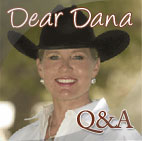More ‘spectacular’ each year
Best and brightest return to SCRCHA Gilkerson event
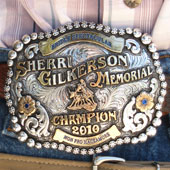 TEMECULA – The Sherri Gilkerson Memorial Bridle Spectacular came to Casner Ranch last month, and with it – for the fourth straight year – came some of the top trainers and horses in the performance horse world.
TEMECULA – The Sherri Gilkerson Memorial Bridle Spectacular came to Casner Ranch last month, and with it – for the fourth straight year – came some of the top trainers and horses in the performance horse world.
The three-day event, co-sponsored by the Southern California Reined Cow Horse Association and the Arizona Reined Cow Horse Association, featured an AQHA cutting on Friday, followed by reined cow horse events Saturday and Sunday that totaled almost $65,000 in pay-outs.
The list of winners reads like a “Who’s Who” in the stock horse world –- Lyn Anderson in the Bridle Spectacular, Lance Johnston in the Hackamore Spectacular, Karen Stallings in the Non-Pro Bridle Spectacular. But the victor here is the show itself, which commemorates the life of fellow trainer and friend Sherri Gilkerson and helps fund the Sherri Gilkerson Memorial Scholarships for undergraduate college and university students with an interest in reined cow horses.
Sermon on the trail
'Deacon' takes Extreme Trail Challenge in Norco
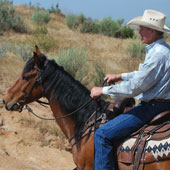
Gary Wedemeyer of Winton and The Deacon win the 2010 Extreme Mustang Makeover Trail Challenge in Norco May 14-16.
The Norco event encompassed more elements than any other Extreme Mustang Makeover held this season. Not only did Mustangs and their trainers compete in the routine body conditioning, but also in hand and under saddle obstacle courses.
How challenging was the four-mile trail course?
“The only way up the hill was with an ATV or horse,” said Mustang Heritage Foundation Executive Director Patti Colbert. “The ruggedness was a production challenge, too. The very best challenge was thanking the more than 40 volunteers that helped us, and eating at every Norco restaurant where we heard ‘there’s those Mustang people, we love you!’ ”
What’s NEW & on SALE at Horse Expo!
![]() Heading to Expo in Sacramento June 11-13th? Learn what’s new and save big, too! Visit our online Expo shopping guide at www.horsetrader.com/expo.
Heading to Expo in Sacramento June 11-13th? Learn what’s new and save big, too! Visit our online Expo shopping guide at www.horsetrader.com/expo.
‘Generation-D’ is on the rise
Doddridge and Davis push leaders in open hunters, jumpers
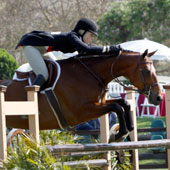
Melissa Doddridge takes Best Man to reserve in the $10,000 Chronicle Of The Horse Hunter Derby May 14 at the Blenheim Ranch and Coast Tournament at Showpark.
Fifty-one horse and rider combinations went for the win in the $50,000 Grand Prix of California presented by Mary’s Tack and Feed on a cool Saturday afternoon. The early rider got the prize, as Canadian John Pearce galloped on the field third in the order and was the first to ride clean on his 14-year-old Danish Warmblood gelding, Chianto. Next clean in the first round was New Zealand rider Guy Thomas and 13-year-old Holsteiner gelding, Carino. Riding seventh in the class, Thomas navigated the course smoothly and accurately. A handful tried to master the course without success until two talented and gutsy young women, Lucy Davis on Old Oak Farm’s Nemo 119 and Ashlee Bond on Little Valley Farm’s GZS Cassir Z, went sixteenth and seventeenth in the order and clean.
Are You Ready to Move On?
Master these skills before you try to train

- When your hands start to feel resistance does an alarm go off in your head telling you to get them moving? You don’t want to move to the next level until you have trained your hands to work the snaffle, not pull on it, and you’re doing it at the walk, the jog and the lope.
- If you lay a leg on your horse and he doesn’t respond, do you instinctively start bumping him with your boot top rather than just squeezing harder? If you’re still squeezing with your legs and not using them in a rhythmic fashion, you need to stay here until the movement is second nature at all three gaits.
Headed to Expo? Check out Horsetrader’s ‘Expo Shopper’s Guide’
California’s biggest homegrown horse exposition since 1999 — the Western States Horse Expo — returns to Cal Expo June 11-13, and the Horsetrader will be there! If you plan on going – or if you are thinking about it – be sure to check out our “Expo Shopper’s Guide” online at http://www.horsetrader.com/expo. We asked every vendor “what’s new in 2010”, so here’s a chance to learn what’s new. And – save BIG, too, with coupons for select vendors in this issue on Page 11. (More online, too!)
Supervisor says horse permitting ‘onerous’
VISTA — A San Diego County Supervisor who was confronted by some some horse owners at a campaign event in May declared that the major use permitting process for horse operations is “too onerous” and then promised to do something about the process.
UC Davis program gets $3 million endowment
DAVIS — The William and Inez Mabie Family Foundation has pledged $3 million to support the Center for Equine Health (CEH) to continue its operational, educational and research efforts to benefit horses. The CEH is part of the School of Veterinary Medicine at the University of California, Davis.
The Mabie Endowment will ensure the permanence of the CEH and allow it to continue its research and educational programs in equine medical science, officials say.
The endowment was offered in the form of a challenge grant whereby an additional $1.8 million must be raised within six years to create a matching endowed directorship position. The requested “Directors Endowment” is a call to the equine industry from the Mabie Foundation to provide the necessary funding to recruit exemplary future leaders of the Center.
“The Mabie Endowment is an invaluable gift to the School of Veterinary Medicine,” said Dr. Gregory Ferraro, DVM, Director of the CEH. “It will allow the Center and our equine faculty to improve the health, performance and welfare of horses in perpetuity. Their gift, combined with the fulfillment of the proposed Directorship Endowment, will position UC Davis permanently as an international leader in equine medical research and education. The vision and leadership provided by the Mabie Foundation on behalf of the horse are to be commended. I can’t thank them enough.”
Persons or organizations interested in meeting the Mabie Foundation’s challenge by contributing to the CEH “Directorship Endowment” campaign should contact Dr. Gregory L. Ferraro at (530) 752-6433, or email: glferraro@ucdavis.edu.
Getting over the teeter-totter is more like climbing a mountain
HEY RAY!: I was working with my 4-year-old Mustang mare, “Cowgirl,” and tried to get her to go over a “teeter-totter” obstacle. She would walk around it, but as soon as I would try to get her to step onto it, she refused. I tried going over the side of it, and the most she would do is jump it and mess around. I stayed out there for a long time, and it didn’t help. How can I fix this?
— Jacky Hare, Silverado, Calif.
HEY JACKY: This is the perfect example of when “minimizing your loss” is the right thing to do. As long as Cowgirl didn’t become stressed out during her experience, this obstacle shouldn’t be that difficult to face again. It boils down to preparing your horse ahead of time with other “walk-ons” and “walk- overs” away from the teeter-totter before coming back to it.
You should have a good handle on your horse before you return to that obstacle. Make sure you can move your horse easily forward, backward and sideways — front-end and hind-end alike. It doesn’t matter what tools you use — hand, rope, stick or wand. Try not to use a sharp whip if you can avoid it because you don’t want to add to the fear and stress she may already be feeling about this challenge. To start, place a pole on the ground about two feet from –and perpendicular to — the fence. Ask your horse to walk in the 2-foot space between the pole and the fence until she feels comfortable and relaxed. You should be positioned as if you were lunging and reversing, over and over again. Next, close the gap between the pole and the fence until she either jumps or walks over the pole, and continue until she walks calmly over it.
Now you can replace the pole with a tarp or sheet of plywood and position them like you did with the pole , leaving a couple feet between the fence and the obstacle. It may be helpful to have one of the corners pointing toward the fence initially since the horse will have an easier time jumping over the corner as opposed to jumping the entire width of the obstacle. As she becomes more accepting of this challenge, close the gap between the obstacle and the fence until she walks calmly over the obstacle.
Jacky, you are on the right track when you proceeded to attempt Cowgirl to cross over the short side of the teeter-totter. Now that we have allowed Cowgirl to hop and skip and jump over these various obstacles along the fence, this will be a perfect time to slip in the teeter-totter. Have her repeat exactly what she has accomplished before. Remember, leave a couple of feet between the obstacle and the fence, and as soon as she becomes comfortable and relaxed, begin closing the gap. Be sure to have the end of the teeter-totter that is facing the fence down. Understand that even though we want her to step on the obstacle, jumping over it is not a refusal — it is actually a good thing. As you repeatedly ask her to go from one side of the obstacle to the other, she will eventually get tired of jumping. Eventually, it will be her idea to put a foot down onto the board and test its safety. Then, one foot will turn into two, than three, and later four — until she will stand on it, stop, rest, and feel as confident as a circus elephant on its platform. You should be rewarding for any effort — as slight as it may be — by stopping, resting, rubbing and scratching. But when she finally stands with at least two feet quietly, make sure you throw a party of praise.
This will be a good time to put her away and have her sleep on it. By the time you take her out for another session, her memory of this experience will have grown. She won’t remember whether she stood on it sideways or long ways. Simply pull the teeter-totter away from the fence and ask her to walk up as if she were going to walk straight through. You can stand on the side of the teeter-totter as if you were loading her into a trailer by sending her in, or you can stand in front of her on the plank and ask her to follow you through. Take great care not to get jumped on or run over the moment the teeter-totter shifts from up to down. I’ve seen horses simply walk all the way through as if they have done it before, and I’ve seen them jump off cat-like in nine different directions. If the first option happens, praise them and give them a moment to understand what they have accomplished, then create a positive pattern by doing it a couple more times before putting her away. If they do a triple back-summersault with a twist in your direction, you do not want to punish them for it, but by the same token you can’t reward them either. So, find a rewardable exercise for Cowgirl, like turning her on the forehand by moving her front end around her hind end two or three times around. Tell her, “Good girl!” and give her as many chances as needed. Eventually, she will prefer to be rewarded for staying on the plank, as scary as it may be, instead of working her butt off at the other rewardable exercise. You need to have faith that this process will work like a charm — it’s not a matter of IF it will work, but a matter of WHEN. It will be sooner than you think. This challenge will be to build a tremendous amount of trust in you and confidence in Cowgirl that will carry over into other challenges in her life. Jacky, I assure you that you will feel much pride in yourself and your horse after going through this experience.
Remember to always trust your instincts and think safe.
RAY
Horsetrader columnist Ray Ariss, husband to Pippa Ariss and father of six, shares his insight into the relationship of horseand human twice each month, in print and on www.horsetrader.com. He lives and trains in “Horsetown USA”, Norco, Calif., at his bustling Starbrite Riding Academy, where he currently has 50 horses in various stages of training, including Andalusians, Friesians, Quarter Horses, Paints, Thoroughbreds, Arabs, Mustangs and more. Ray attributes his training success to the support of his wife and partner, Pippa, and a system he calls S.W.A.P., to which he credits his multiple championships in several disciplines. His passionate understanding of the “human-horse” relationship was evident when he took on the challenge of training a wild Mustang and — in just 100 days — produced the highest-priced adopted Mustang ever — $50,000. Does your “horse-human relationship” leave you with a question for Ray? Click here to submit one!
Dear Dana: Did spring grass ‘freshen up’ my show horse?
DEAR DANA: My trainer had been feeding my horse feed with a high sugar content. I continued to feed it to him. I noticed when I took him to a show he started out fine and laid back, but as the day went on he would get hyper. Last July, after I started feeding whole oats, the problem was solved. Recently I took him to the first show of the year, and we had the same problem — he even bucked in equitation! Do you think that SPRING grass could have had the same effect that the sugary feed did? He gets turned out for several hours a day. There has been quite a lot of rain and the grass is really growing. It didn”t seem to bother him in the summer, but the spring grass is really lush. Help!
–Sharon LeClair, Lawrence, Kansas
DEAR SHARON: That is a very good question — and it addresses some common problems that all of us who show horses have to deal with. First of all, as you have found out, feed can definitely affect your horse’s energy level. I live on the West Coast and I don’t have grass pastures, but my experience with grass is that it usually would not make your horse really high. In my opinion, it was probably the first show of the year and he was just fresh and full of energy. I have found that even older, experienced show horses will be fresher at the first few shows of the year.
It sounds like the answer to your problems involves developing the strategy that works for you and your horse. I can tell you as a trainer that some of my horses are more easily affected by variables such as weather, feed and new environments than others. With one of my mares, I always went to a major show a day early just so that she could “settle in.” Later in her career, I was able to leave on schedule with that mare, and she was good the first day of the show. She needed time, and I gave her the time she needed.
I have also found that if I have a horse settled in and ready to show early in the day, some horses will “freshen up” later in the day and my need to be re-lunged. You will need to experiment with a lower protein, lower sugar feed program and pay attention to your horse’s energy level. Keep in mind many horses will re-energize throughout the day. My guess is that after a few shows, your horse will settle in and be back to his old self.
Dana
Have your own question for Dana? If so, click here! If your question is used in “Dear Dana”, you will be entered into a monthly drawing for a FREE “Winning Strides” DVD!
Sign up for Dana’s newsletter and keep up with Dana’s updates, new products and clinic schedule! When you register, you are automatically entered into a quarterly raffle for great prizes, including a FREE personal training session with Dana! Click here to sign up now!


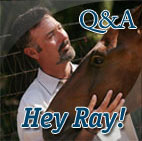
 Read Columns
Read Columns
